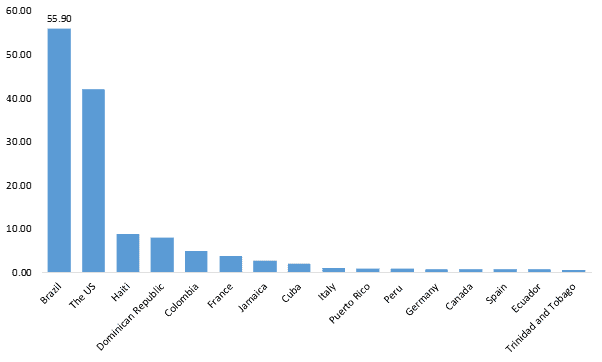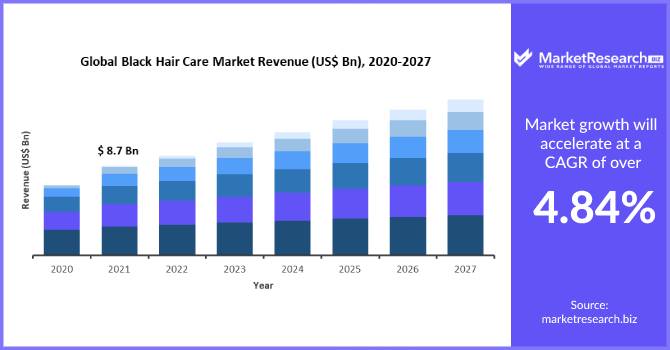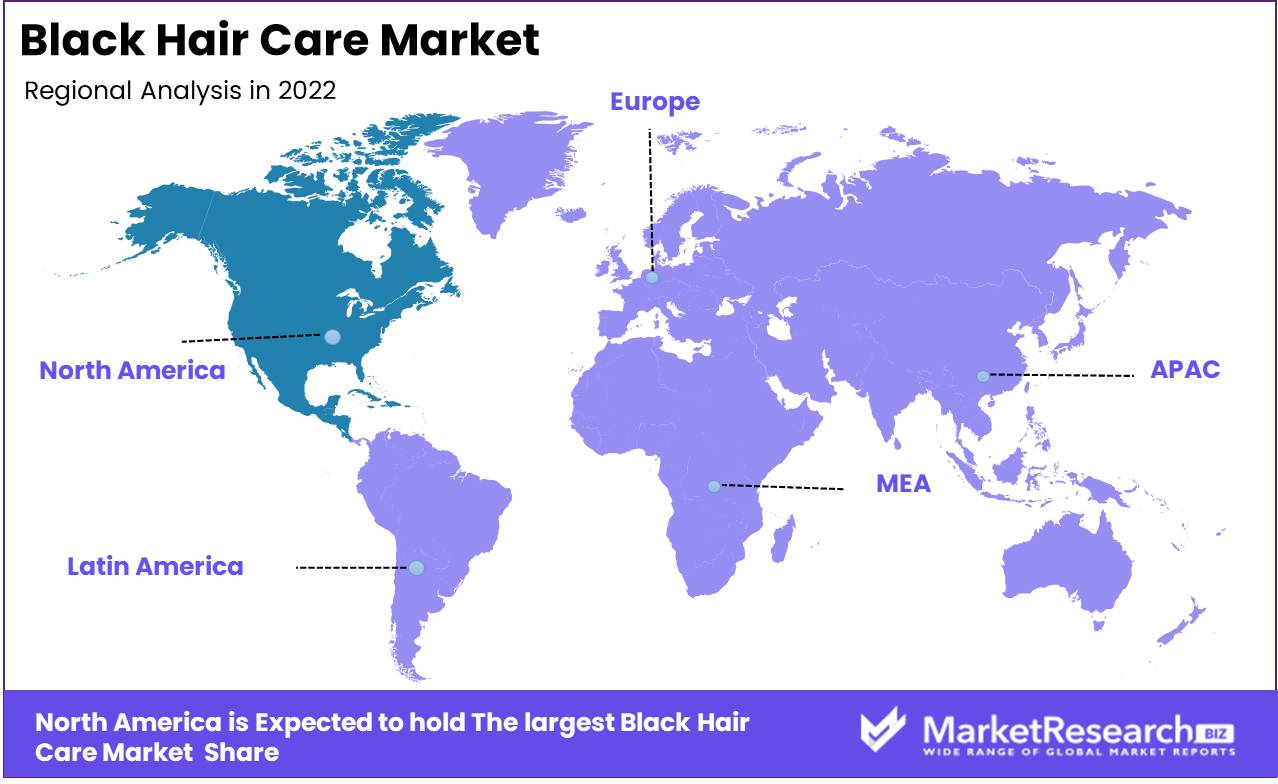
Black Hair Care Market by Product Type (Shampoo, Hair Oil, Conditioner, Other Product Types), by End-Use(Men, Women, Kids), by Distribution Channel (Hypermarket/Supermarket, Online Platforms, Retail Stores), by Region And Companies - Industry Segment Outlook, Market Assessment, Competition Scenario, Trends, And Forecast 2023-2032
-
27523
-
May 2023
-
158
-
-
This report was compiled by Correspondence Linkedin | Detailed Market research Methodology Our methodology involves a mix of primary research, including interviews with leading mental health experts, and secondary research from reputable medical journals and databases. View Detailed Methodology Page
-
“The Global Black Hair Care Market size is expected to be worth around US$ 9.56 Billion by 2023 to US$ 15.34 Billion in 2033, growing at a CAGR of 4.84% during the forecast period 2023 to 2033.”
Black Hair Care Market Overview :
In 2017, about 140 million people were in the African diaspora, of which more than 25 million live outside the African continent. By the end of this century, the African population is likely to be 40% of the global population. African-American and black consumers consider their hair to be an integral feature of their appearance.
Their hair is often of a diverse range of thickness and texture. It is generally curly or spiral and mostly braided, permed, or in locks, making them prone to damage. Over the last few years, hair care has become one of the utmost concerns amongst the black community.
In recent years, black consumers have consciously shifted from general hair care products to specific black hair care products. In the US, it is estimated that black women spend about US$ 3,000 each year on hair care, which is relatively higher than their white counterparts.
Major players operating in the hair care segment have noticed this niche community and its immense potential and have launched several products to cater to this segment specifically.
African Diaspora (Population in Million) outside of Africa,2019:

To learn more about this report, request for sample report
Increased spending by the black community has resulted in several offerings, particularly for the black consumers. Growing demand for organic/natural products for personal grooming has become one of the main concerns for individuals worldwide.
Now, consumers are mindful of the negative effect of prolonged use of chemical-based products. This has resulted in a significant shift from products containing endocrine-disrupting chemicals (EDCs) to natural products such as aloe vera, coconut water, coconut oil, shea butter, and argan oil.

The recent COVID-19 pandemic has caused unprecedented damage to the overall beauty industry. But in contrast, the skin-care and hair-care segments benefitted from the self-care and pampering trends during the lockdown. Moreover, collaborations in the value chain and increasing partnerships are expected to shape the future of this thriving industry.
Market Dynamics:
African Americans command the ethnic hair and beauty aids category, accounting for almost 90% of the overall spend. This has led to a significant development in product innovation. For instance, Unilever focuses on its two most prominent brands, Dove and Suave, to improve the textured hair of the colored community.
Furthermore, the market has also witnessed acquisitions by large-scale personal care companies of their counterparts that cater to the specific consumer segment. Cosmetics giant L'Oréal observed the potential of this untapped market and acquired Carol's Daughter in 2014, which produces skin and hair-care products for black women. The company offers a broad range of products that are available at specialty beauty stores, mass retailers, e-commerce portals, and branded stores in various cities in the US.Empower diverse beauty with specialized products, as the Black Hair Care market celebrates unique textures and cultural identity in every strand.
List of Black Hair Care Products, 2020:
Company Headquarters Products TGIN – Thank God It’s Natural The US XXX Mielle Organics The US XXX XXX XXX XXX XXX XXX XXX XXX XXX XXX XXX XXX XXX XXX XXX XXX XXX XXX XXX To learn more about this report, request for sample report
Increasing number of smartphone users, growing popularity of online markets and social media websites used for product advertisement, has been gaining significant traction in the recent years. As compared to other consumers, black consumers are more influenced by the advertisements for personal care products. This is significant factor which is expected to fuel demand for haircare products in the coming years.
How are the recent trends shaping the industry in the coming years?
The COVID-19 pandemic was a boon to the hair care industry, especially for the natural black hair. With the lockdown, most of the salons and barbershops were closed for the black community, which left them only with the option of self-care. Several companies and chain stores have reported increased sales of black hair-care products.
Grocery chain Kroger Co. had added shelf space especially for black hair-care products and Indian Godrej Consumer Products plans to revive its Afro Sheen product line after a two decade hiatus. This is likely to provide lucrative opportunities for the market growth over the forecast period.
Regional Analysis:
North America is anticipated to hold a significant share of the global black hair care market. The region is also anticipated to register the highest growth rates over the forecast period. High population concentration of the African diaspora, coupled with higher spending from this community are the key factors contributing to the growth of the market in the region. Increasing product offerings and innovations in product development are estimated to provide a balanced growth in the coming years.

Competitive Landscape:
The black hair care market landscape appears highly consolidated, with a significant chunk of it being dominated by players in the North America region.
- Procter & Gamble
- Unilever
- L'Oréal
- Revlon
- Amka Products
- Shea Moisture
- Alodia Hair Care
- Ouidad
- Afrocenchix
- Uhuru Naturals
- Other Key Players
Some notable developments in the market include:
- US-based Diva By Cindy – a black hair care brand has created hair vending machines that permit customers to independently purchase the company’s products. Prior to the pandemic, the company sold its products through various channels.
- Post COVID-19 pandemic, the company focused its sales mainy through online portals. Closures of malls and retail stores during the pandemic, have prompted the company to sell its products through specialized vending machines, one of which is located at Fort Belvoir army base.
- UK-based Nylah’s Naturals is specifically for afro-textured and curly hair. The company has 100% vegan, paraben-free,cruelty-free, and zero artificial fragrances haircare line products.
- The company recently received a US$ 68,000 funding for a 20% stake in the company from Dragon Den investors. The funding is going to be utilized for scaling the R&D and adding new products to the existing line of products.
Report Scope
- Forecast Period: 2023-2033
- Actual Year: 2022
- Historical Data Available for: 2017-2023
Key Regions Covered
- North America
- Europe
- Asia Pacific
- Latin America
- Middle East & Africa
Key Segments Covered
Black Hair Care Market, By Product Type
- Shampoo
- Hair Oil
- Conditioner
- Other Product Types
Black Hair Care Market, By End-Use
- Men
- Women
- Kids
Black Hair Care Market, By Distribution Channel
- Hypermarket/Supermarket
- Online Platforms
- Retail Stores
Attribute Report Details Market Size US$ 9.56 Billion Growth Rate 4.84% Key Companies Ask For Companies Report Coverage Revenue Forecast, Market Dynamics, COVID-19 Impact, Competitive Landscape, Recent Developments Historical Data Period 2017-2023 Base Year 2022 Forecast Period 2023-2033 Region Scope North America, Europe, Asia-Pacific, South America, Middle East & Africa Country Scope United States, Canada and Mexico, Germany, France, UK, Russia and Italy, China, Japan, Korea, India and Southeast Asia, Brazil, Argentina, Colombia etc.Saudi Arabia, UAE, Egypt, Nigeria and South Africa Revenue in US$ Mn To learn more about this report, request for sample report
-
- Chapter 1 Global Black Hair Care Market Outlook
- 1.1 Introduction
- 1.2 Segmentation Based On Product Type, End-Use, Distribution Channel and Region
- 1.3 Market Drivers
- 1.4 Market Restraints
- 1.5 Market Opportunities
- 1.6 Market Trends
- 1.7 Macro-economic Factors
- 1.8 Regulatory Framework
- 1.9 Global Black Hair Care Market Pricing Analysis by Region, 2021
- 1.10 Opportunity Map Analysis
- 1.10.1 Optimistic Scenario
- 1.10.2 Likely Scenario
- 1.10.3 Conservative Scenario
- 1.11 Opportunity Orbits
- 1.12 Market Investment Feasibility Index
- 1.13 PEST Analysis
- 1.14 PORTER’S Five Force Analysis
- 1.15 Drivers & Restraints Impact Analysis
- 1.16 Marketing Strategy
- 1.17 Product Life Cycle Analysis
- 1.18 Value Chain Analysis
- 1.19 Cost Structure Analysis
- 1.20 Regional Market Share and BPS Analysis
- 1.21 COVID-19 Impact Analysis
- Chapter 2 Global Black Hair Care Market Overview
- 2.1 Global Market Value & Volume Comparison by Product Type (2015-2031)
- 2.1.1 Global Market Value & Volume Market Share by Product Type in 2021
- 2.1.2 Global Market Attractiveness Analysis by Product Type, 2015–2022
- 2.2 Global Market Value & Volume Comparison by End-Use (2015-2031)
- 2.2.1 Global Market Value & Volume Market Share by End-Use in 2021
- 2.2.2 Global Market Attractiveness Analysis by End-Use, 2015–2022
- 2.3 Global Market by Distribution Channel
- 2.3.1 Global Market Value & Volume Comparison by Distribution Channel (2015-2031)
- 2.3.2 Global Market Value & Volume Market Share by Distribution Channel in 2021
- 2.3.3 Global Market Attractiveness Analysis by Distribution Channel, 2015–2022
- 2.4 Global Market Outlook by Region
- 2.4.1 Global Market Value & Volume Comparison by Region (2015-2031)
- 2.4.2 Global Market Value & Volume Market Share by Region in 2021
- 2.4.3 Global Market Attractiveness Analysis by Region, 2015–2022
- 2.5 Global Market Outlook (2015-2031)
- 2.5.1 Global Market Value & Volume (2015–2022)
- 2.5.2 Global Market Value & Volume (2023-2031)
- 2.6 Global Market Value & Volume by Regions
- 2.6.1 Global Market Value & Volume Comparison by Region (2015–2022)
- 2.6.2 Global Market Value & Volume Comparison by Region (2023-2031)
- 2.7 Global Market Value & Volume by Product Type
- 2.7.1 Global Market Value & Volume Comparison by Product Type (2015–2022)
- 2.7.2 Global Market Value & Volume Comparison by Product Type (2023-2031)
- 2.8 Global Market Value & Volume by End-Use
- 2.8.1 Global Market Value & Volume Comparison by End-Use (2015–2022)
- 2.8.2 Global Market Value & Volume Comparison by End-Use (2023-2031)
- 2.9 Global Market Value & Volume by Distribution Channel
- 2.9.1 Global Market Value & Volume Comparison by Distribution Channel (2015–2022)
- 2.9.2 Global Market Value & Volume Comparison by Distribution Channel (2023-2031)
- 2.10 Global Market Y-o-Y Growth Rate Comparison 2016–2031
- 2.10.1 Global Market Y-o-Y Growth Rate by Region
- 2.10.2 Global Market Y-o-Y Growth Rate by Product Type
- 2.10.3 Global Market Y-o-Y Growth Rate by End-Use
- 2.10.4 Global Market Y-o-Y Growth Rate by Distribution Channel
- 2.11 Global Market Share Comparison 2015–2030
- 2.11.1 Global Market Share by Region
- 2.11.2 Global Market Share by Product Type
- 2.11.3 Global Market Share by End-Use
- 2.11.4 Global Market Share by Distribution Channel
- 2.1 Global Market Value & Volume Comparison by Product Type (2015-2031)
- Chapter 3 North America Black Hair Care Market Overview
- 3.1 North America Market by Product Type
- 3.1.1 North America Market Value & Volume Comparison by Product Type (2015-2031)
- 3.1.2 North America Market Value & Volume Market Share by Product Type in 2021
- 3.2 North America Market Value & Volume Comparison by End-Use (2015-2031)
- 3.2.1 North America Market Value & Volume Market Share by End-Use in 2021
- 3.2.2 North America Market Attractiveness Analysis by End-Use, 2015–2022
- 3.3 North America Market by Distribution Channel
- 3.3.1 North America Market Value & Volume Comparison by Distribution Channel (2015-2031)
- 3.3.2 North America Market Value & Volume Market Share by Distribution Channel in 2021
- 3.3.3 North America Market Attractiveness Analysis by Distribution Channel, 2015–2022
- 3.4 North America Market Outlook by Region
- 3.4.1 North America Market Value & Volume Comparison by Region (2015-2031)
- 3.4.2 North America Market Value & Volume Market Share by Region in 2021
- 3.4.3 North America Market Attractiveness Analysis by Region, 2015–2022
- 3.5 North America Market Outlook (2015-2031)
- 3.5.1 North America Market Value & Volume (2015–2022)
- 3.5.2 North America Market Value & Volume (2023-2031)
- 3.6 North America Market Value & Volume by Regions
- 3.6.1 North America Market Value & Volume Comparison by Region (2015–2022)
- 3.6.2 North America Market Value & Volume Comparison by Region (2023-2031)
- 3.7 North America Market Value & Volume by Product Type
- 3.7.1 North America Market Value & Volume Comparison by Product Type (2015–2022)
- 3.7.2 North America Market Value & Volume Comparison by Product Type (2023-2031)
- 3.8 North America Market Value & Volume by End-Use
- 3.8.1 North America Market Value & Volume Comparison by End-Use (2015–2022)
- 3.8.2 North America Market Value & Volume Comparison by End-Use (2023-2031)
- 3.9 North America Market Value & Volume by Distribution Channel
- 3.9.1 North America Market Value & Volume Comparison by Distribution Channel (2015–2022)
- 3.9.2 North America Market Value & Volume Comparison by Distribution Channel (2023-2031)
- 3.10 North America Market Y-o-Y Growth Rate Comparison 2016–2031
- 3.10.1 North America Market Y-o-Y Growth Rate by Region
- 3.10.2 North America Market Y-o-Y Growth Rate by Product Type
- 3.10.3 North America Market Y-o-Y Growth Rate by End-Use
- 3.10.4 North America Market Y-o-Y Growth Rate by Distribution Channel
- 3.11 North America Market Share Comparison 2015–2030
- 2.11.1 North America Market Share by Region
- 3.11.2 North America Market Share by Product Type
- 3.11.3 North America Market Share by End-Use
- 3.11.4 North America Market Share by Distribution Channel
- 3.1 North America Market by Product Type
- Chapter 4 Europe Black Hair Care Market Overview
- 4.1 Europe Market by Product Type
- 4.1.1 Europe Market Value & Volume Comparison by Product Type (2015-2031)
- 4.1.2 Europe Market Value & Volume Market Share by Product Type in 2021
- 4.2 Europe Market Value & Volume Comparison by End-Use (2015-2031)
- 4.2.1 Europe Market Value & Volume Market Share by End-Use in 2021
- 4.2.2 Europe Market Attractiveness Analysis by End-Use, 2015–2022
- 4.3 Europe Market by Distribution Channel
- 4.3.1 Europe Market Value & Volume Comparison by Distribution Channel (2015-2031)
- 4.3.2 Europe Market Value & Volume Market Share by Distribution Channel in 2021
- 4.3.3 Europe Market Attractiveness Analysis by Distribution Channel, 2015–2022
- 4.4 Europe Market Outlook by Region
- 4.4.1 Europe Market Value & Volume Comparison by Region (2015-2031)
- 4.4.2 Europe Market Value & Volume Market Share by Region in 2021
- 4.4.3 Europe Market Attractiveness Analysis by Region, 2015–2022
- 4.5 Europe Market Outlook (2015-2031)
- 4.5.1 Europe Market Value & Volume (2015–2022)
- 4.5.2 Europe Market Value & Volume (2023-2031)
- 4.6 Europe Market Value & Volume by Regions
- 4.6.1 Europe Market Value & Volume Comparison by Region (2015–2022)
- 4.6.2 Europe Market Value & Volume Comparison by Region (2023-2031)
- 4.7 Europe Market Value & Volume by Product Type
- 4.7.1 Europe Market Value & Volume Comparison by Product Type (2015–2022)
- 4.7.2 Europe Market Value & Volume Comparison by Product Type (2023-2031)
- 4.8 Europe Market Value & Volume by End-Use
- 4.8.1 Europe Market Value & Volume Comparison by End-Use (2015–2022)
- 4.8.2 Europe Market Value & Volume Comparison by End-Use (2023-2031)
- 4.9 Europe Market Value & Volume by Distribution Channel
- 4.9.1 Europe Market Value & Volume Comparison by Distribution Channel (2015–2022)
- 4.9.2 Europe Market Value & Volume Comparison by Distribution Channel (2023-2031)
- 4.9 Europe Market Y-o-Y Growth Rate Comparison 2016–2031
- 4.10.1 Europe Market Y-o-Y Growth Rate by Region
- 4.10.2 Europe Market Y-o-Y Growth Rate by Product Type
- 4.10.3 Europe Market Y-o-Y Growth Rate by End-Use
- 4.10.4 Europe Market Y-o-Y Growth Rate by Distribution Channel
- 4.11 Europe Market Share Comparison 2015–2030
- 4.11.1 Europe Market Share by Region
- 4.11.2 Europe Market Share by Product Type
- 4.11.3 Europe Market Share by End-Use
- 4.11.4 Europe Market Share by Distribution Channel
- 4.1 Europe Market by Product Type
- Chapter 5 Asia-Pacific Black Hair Care Market Overview
- 5.1 Asia-Pacific Market by Product Type
- 5.1.1 Asia-Pacific Market Value & Volume Comparison by Product Type (2015-2031)
- 5.1.2 Asia-Pacific Market Value & Volume Market Share by Product Type in 2021
- 5.2 Asia-Pacific Market Value & Volume Comparison by End-Use (2015-2031)
- 5.2.1 Asia-Pacific Market Value & Volume Market Share by End-Use in 2021
- 5.2.2 Asia-Pacific Market Attractiveness Analysis by End-Use, 2015–2022
- 5.3 Asia-Pacific Market by Distribution Channel
- 5.3.1 Asia-Pacific Market Value & Volume Comparison by Distribution Channel (2015-2031)
- 5.3.2 Asia-Pacific Market Value & Volume Market Share by Distribution Channel in 2021
- 5.3.3 Asia-Pacific Market Attractiveness Analysis by Distribution Channel, 2015–2022
- 5.4 Asia-Pacific Market Outlook by Region
- 5.4.1 Asia-Pacific Market Value & Volume Comparison by Region (2015-2031)
- 5.4.2 Asia-Pacific Market Value & Volume Market Share by Region in 2021
- 5.4.3 Asia-Pacific Market Attractiveness Analysis by Region, 2015–2022
- 5.5 Asia-Pacific Market Outlook (2015-2031)
- 5.5.1 Asia-Pacific Market Value & Volume (2015–2022)
- 5.5.2 Asia-Pacific Market Value & Volume (2023-2031)
- 5.6 Asia-Pacific Market Value & Volume by Regions
- 5.6.1 Asia-Pacific Market Value & Volume Comparison by Region (2015–2022)
- 5.6.2 Asia-Pacific Market Value & Volume Comparison by Region (2023-2031)
- 5.7 Asia-Pacific Market Value & Volume by Product Type
- 5.7.1 Asia-Pacific Market Value & Volume Comparison by Product Type (2015–2022)
- 5.7.2 Asia-Pacific Market Value & Volume Comparison by Product Type (2023-2031)
- 5.8 Asia-Pacific Market Value & Volume by End-Use
- 5.8.1 Asia-Pacific Market Value & Volume Comparison by End-Use (2015–2022)
- 5.8.2 Asia-Pacific Market Value & Volume Comparison by End-Use (2023-2031)
- 5.9 Asia-Pacific Market Value & Volume by Distribution Channel
- 5.9.1 Asia-Pacific Market Value & Volume Comparison by Distribution Channel (2015–2022)
- 5.9.2 Asia-Pacific Market Value & Volume Comparison by Distribution Channel (2023-2031)
- 5.10 Asia-Pacific Market Y-o-Y Growth Rate Comparison 2016–2031
- 5.10.1 Asia-Pacific Market Y-o-Y Growth Rate by Region
- 5.10.2 Asia-Pacific Market Y-o-Y Growth Rate by Product Type
- 5.10.3 Asia-Pacific Market Y-o-Y Growth Rate by End-Use
- 5.10.4 Asia-Pacific Market Y-o-Y Growth Rate by Distribution Channel
- 5.11 Asia-Pacific Market Share Comparison 2015–2030
- 5.11.1 Asia-Pacific Market Share by Region
- 5.11.2 Asia-Pacific Market Share by Product Type
- 5.11.3 Asia-Pacific Market Share by End-Use
- 5.11.4 Asia-Pacific Market Share by Distribution Channel
- 5.1 Asia-Pacific Market by Product Type
- Chapter 6 Latin America Black Hair Care Market Overview
- 6.1 Latin America Market by Product Type
- 6.1.1 Latin America Market Value & Volume Comparison by Product Type (2015-2031)
- 6.1.2 Latin America Market Value & Volume Market Share by Product Type in 2021
- 6.2 Latin America Market Value & Volume Comparison by End-Use (2015-2031)
- 6.2.1 Latin America Market Value & Volume Market Share by End-Use in 2021
- 6.2.2 Latin America Market Attractiveness Analysis by End-Use, 2015–2022
- 6.3 Latin America Market by Distribution Channel
- 6.3.1 Latin America Market Value & Volume Comparison by Distribution Channel (2015-2031)
- 6.3.2 Latin America Market Value & Volume Market Share by Distribution Channel in 2021
- 6.3.3 Latin America Market Attractiveness Analysis by Distribution Channel, 2015–2022
- 6.4 Latin America Market Outlook by Region
- 6.4.1 Latin America Market Value & Volume Comparison by Region (2015-2031)
- 6.4.2 Latin America Market Value & Volume Market Share by Region in 2021
- 6.4.3 Latin America Market Attractiveness Analysis by Region, 2015–2022
- 6.5 Latin America Market Outlook (2015-2031)
- 6.5.1 Latin America Market Value & Volume (2015–2022)
- 6.5.2 Latin America Market Value & Volume (2023-2031)
- 6.6 Latin America Market Value & Volume by Regions
- 6.6.1 Latin America Market Value & Volume Comparison by Region (2015–2022)
- 6.6.2 Latin America Market Value & Volume Comparison by Region (2023-2031)
- 6.7 Latin America Market Value & Volume by Product Type
- 6.7.1 Latin America Market Value & Volume Comparison by Product Type (2015–2022)
- 6.7.2 Latin America Market Value & Volume Comparison by Product Type (2023-2031)
- 6.8 Latin America Market Value & Volume by End-Use
- 6.8.1 Latin America Market Value & Volume Comparison by End-Use (2015–2022)
- 6.8.2 Latin America Market Value & Volume Comparison by End-Use (2023-2031)
- 6.9 Latin America Market Value & Volume by Distribution Channel
- 6.9.1 Latin America Market Value & Volume Comparison by Distribution Channel (2015–2022)
- 6.9.2 Latin America Market Value & Volume Comparison by Distribution Channel (2023-2031)
- 6.10 Latin America Market Y-o-Y Growth Rate Comparison 2016–2031
- 6.10.1 Latin America Market Y-o-Y Growth Rate by Region
- 6.10.2 Latin America Market Y-o-Y Growth Rate by Product Type
- 6.10.3 Latin America Market Y-o-Y Growth Rate by End-Use
- 6.10.4 Latin America Market Y-o-Y Growth Rate by Distribution Channel
- 6.11 Latin America Market Share Comparison 2015–2030
- 6.11.1 Latin America Market Share by Region
- 6.11.2 Latin America Market Share by Product Type
- 6.11.3 Latin America Market Share by End-Use
- 6.11.4 Latin America Market Share by Distribution Channel
- 6.1 Latin America Market by Product Type
- Chapter 7 MEA Black Hair Care Market Overview
- 7.1 MEA Market by Product Type
- 7.1.1 MEA Market Value & Volume Comparison by Product Type (2015-2031)
- 7.1.2 MEA Market Value & Volume Market Share by Product Type in 2021
- 7.2 MEA Market Value & Volume Comparison by End-Use (2015-2031)
- 7.2.1 MEA Market Value & Volume Market Share by End-Use in 2021
- 7.2.2 MEA Market Attractiveness Analysis by End-Use, 2015–2022
- 7.3 MEA Market by Distribution Channel
- 7.3.1 MEA Market Value & Volume Comparison by Distribution Channel (2015-2031)
- 7.3.2 MEA Market Value & Volume Market Share by Distribution Channel in 2021
- 7.3.3 MEA Market Attractiveness Analysis by Distribution Channel, 2015–2022
- 7.4 MEA Market Outlook by Region
- 7.4.1 MEA Market Value & Volume Comparison by Region (2015-2031)
- 7.4.2 MEA Market Value & Volume Market Share by Region in 2021
- 7.4.3 MEA Market Attractiveness Analysis by Region, 2015–2022
- 7.5 MEA Market Outlook (2015-2031)
- 7.5.1 MEA Market Value & Volume (2015–2022)
- 7.5.2 MEA Market Value & Volume (2023-2031)
- 7.5 MEA Market Value & Volume by Regions
- 7.6.1 MEA Market Value & Volume Comparison by Region (2015–2022)
- 7.6.2 MEA Market Value & Volume Comparison by Region (2023-2031)
- 7.7 MEA Market Value & Volume by Product Type
- 7.7.1 MEA Market Value & Volume Comparison by Product Type (2015–2022)
- 7.7.2 MEA Market Value & Volume Comparison by Product Type (2023-2031)
- 7.8 MEA Market Value & Volume by End-Use
- 7.8.1 MEA Market Value & Volume Comparison by End-Use (2015–2022)
- 7.8.2 MEA Market Value & Volume Comparison by End-Use (2023-2031)
- 7.9 MEA Market Value & Volume by Distribution Channel
- 7.9.1 MEA Market Value & Volume Comparison by Distribution Channel (2015–2022)
- 7.9.2 MEA Market Value & Volume Comparison by Distribution Channel (2023-2031)
- 7.10 MEA Market Y-o-Y Growth Rate Comparison 2016–2031
- 7.10.1 MEA Market Y-o-Y Growth Rate by Region
- 7.10.2 MEA Market Y-o-Y Growth Rate by Product Type
- 7.10.3 MEA Market Y-o-Y Growth Rate by End-Use
- 7.10.4 MEA Market Y-o-Y Growth Rate by Distribution Channel
- 7.11 MEA Market Share Comparison 2015–2030
- 7.11.1 MEA Market Share by Region
- 7.11.2 MEA Market Share by Product Type
- 7.11.3 MEA Market Share by End-Use
- 7.11.4 MEA Market Share by Distribution Channel
- 7.1 MEA Market by Product Type
- Chapter 8 Global Black Hair Care Market Company Profiles
- 8.1 Market Competition Scenario Analysis, By Company
- 8.2 Competitor Landscape
- 8.3 Company Share Analysis
- 8.4 Company Profiles
- 8.4.1 Procter & Gamble
- 8.4.1.1 Company Overview
- 8.4.1.2 Business Description
- 8.4.1.3 Product Portfolio
- 8.4.1.4 Key Financials
- 8.4.1.5 Key Developments
- 8.4.1.6 SWOT Analysis
- 8.4.2 Unilever
- 8.4.2.1 Company Overview
- 8.4.2.2 Business Description
- 8.4.2.3 Product Portfolio
- 8.4.2.4 Key Financials
- 8.4.2.5 Key Developments
- 8.4.2.6 SWOT Analysis
- 8.4.3 L’Oréal
- 8.4.3.1 Company Overview
- 8.4.3.2 Business Description
- 8.4.3.3 Product Portfolio
- 8.4.3.4 Key Financials
- 8.4.3.5 Key Developments
- 8.4.3.6 SWOT Analysis
- 8.4.4 Revlon
- 8.4.4.1 Company Overview
- 8.4.4.2 Business Description
- 8.4.4.3 Product Portfolio
- 8.4.4.4 Key Financials
- 8.4.4.5 Key Developments
- 8.4.4.6 SWOT Analysis
- 8.4.5 Amka Products
- 8.4.5.1 Company Overview
- 8.4.5.2 Business Description
- 8.4.5.3 Product Portfolio
- 8.4.5.4 Key Financials
- 8.4.5.5 Key Developments
- 8.4.5.6 SWOT Analysis
- 8.4.6 Shea Moisture
- 8.4.6.1 Company Overview
- 8.4.6.2 Business Description
- 8.4.6.3 Product Portfolio
- 8.4.6.4 Key Financials
- 8.4.6.5 Key Developments
- 8.4.6.6 SWOT Analysis
- 8.4.7 Alodia Hair Care
- 8.4.7.1 Company Overview
- 8.4.7.2 Business Description
- 8.4.7.3 Product Portfolio
- 8.4.7.4 Key Financials
- 8.4.7.5 Key Developments
- 8.4.7.6 SWOT Analysis
- 8.4.8 Ouidad
- 8.4.8.1 Company Overview
- 8.4.8.2 Business Description
- 8.4.8.3 Product Portfolio
- 8.4.8.4 Key Financials
- 8.4.8.5 Key Developments
- 8.4.8.6 SWOT Analysis
- 8.4.9 Afrocenchix
- 8.4.9.1 Company Overview
- 8.4.9.2 Business Description
- 8.4.9.3 Product Portfolio
- 8.4.9.4 Key Financials
- 8.4.9.5 Key Developments
- 8.4.9.6 SWOT Analysis
- 8.4.10 Uhuru Naturals
- 8.4.10.1 Company Overview
- 8.4.10.2 Business Description
- 8.4.10.3 Product Portfolio
- 8.4.10.4 Key Financials
- 8.4.10.5 Key Developments
- 8.4.10.6 SWOT Analysis
- 8.4.11 Other Key Players
- 8.4.1 Procter & Gamble
- Chapter 9 Research Methodology
- 9.1 Research Methodology
- 9.2 Primary Research
- 9.3 Secondary Research
- 9.4 Report Scope
- Chapter 10 About Us
- 10.1 Who we are:
- Chapter 11 Disclaimer
To learn more about this report, request for sample report
- Chapter 1 Global Black Hair Care Market Outlook
-
- Procter & Gamble
- Unilever
- L'Oréal
- Revlon
- Amka Products
- Shea Moisture
- Alodia Hair Care
- Ouidad
- Afrocenchix
- Uhuru Naturals
- Other Key Players




